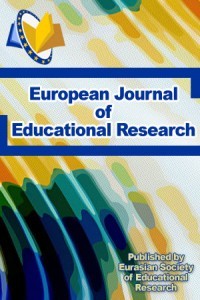The Open-Ended Approach Framework
The Open-Ended Approach Framework
Open-ended problems, open approach, mathematics education, teaching methods teaching practice,
___
- Becker, J. P., & Shimada, S. (1997). The open-ended approach: A new proposal for teaching mathematics: Reston, Virgina. Mathematics National Council of Teachers of Mathematics, INC.
- Bogdan, R. C., & Biklen, S. K. (1992). Qualitative research in education: An introduction to theory and methods. Boston: Allyn and Bacon.
- Carroll, W.M. (1999). Using short questions to develop and assess reasoning. In L.V. Stiff & F.R. Curcio (Eds.). Developing mathematical reasoning in grades K-12 (pp. 247-255). Reston, VA: National Council of Teachers of Mathematics.
- Cooper, B., & Dunne, M. (1998). Anyone for tennis? Social class differences in children's responses to national curriculum mathematics testing. The Sociological Review, 41(1), 115-148.
- Floriano, V. (2012) Open-ended tasks in the promotion of classroom communication in mathematics. International Electronic Journal of Elementary Education, 4(2), 287-300.
- Kilpatrick, J., Swafford, J., & Findell, B. (2001). Adding it Up: Helping children learn mathematics. Washington, DC: National Academy Press.
- Kabiri, M., Smith, L. N. (2003). Turning traditional problems into open-ended problems. Mathematics Teaching in the Middle School, 9(3), 186- 192.
- Lewis, C. C. (1995). Educating hearts and minds: Reflections on Japanese preschool and elementary education. Cambridge: Cambridge University Press.
- Limjap, A. A. (2001). Issues on Problem Solving: Drawing Implications for a Techno-Mathematics Curriculum at the Collegiate Level.
- Maitree, I. (2006). Open-ended approach and teachers education, center for research in mathematics education faculty of education. Tsukuba Journal of Educational Study in Mathematics, 25, 169-177.
- Munroe L. (2015). Observations of Classroom Practice. Using the Open Approach to Teach Mathematics in a Grade Six Class in Japan. Paper presented at EARCOME 7, Philippines.
- National Council of Teachers of Mathematics NCTM (1997). Multiple solutions to problems in mathematics teaching: Do teachers really value them? Principles and standards for school mathematics.
- Nohda, N. (2000). A Study of "Open-Approach" method in School Mathematics Teaching. Paper presented at the 10th ICME, Makuhari, Japan.
- Ontario Ministry of Education (2011). Capacity building series provoking student thinking/deepening conceptual understanding in the mathematics classroom. Eight tips for asking effective questions.
- Ontario Ministry of Education. (2006). A guide to effective instruction in mathematics, Kindergarten to Grade 6. 2: Problem solving and communication. Toronto: Queen's Printer.
- Phonapichat, P., Wongwanich, S., & Sujiva, S. (2014). An analysis of elementary school students’ difficulties in mathematical problem solving. Procedia-Social and Behavioral Sciences, 116, 3169-3174.
- Radley, K. M. (2007). Open-ended approach to teaching and learning of high school mathematics. Vaal University of Technology, South Africa.
- Sekiguchi, Y. (2006). Development of mathematical norms in an eight-grade Japanese classroom. The learners’ perspective study. In: D. Clarke, C. Keitel & Y.Shimizu (Eds.), Mathematics classroom in twelve countries: The Insiders’ perspective (pp. 289-306). Dordrecht: Sense Publishers
- Sekiguchi, Y. (2002). Mathematical proof, argumentation, and classroom communication: from a cultural perspective. Tsukuba Journal of Educational Study in Mathematics, 21, 11-20.
- Shimada, S. (ed.) 1977. Open-end approach in arithmetic and mathematics - A new Proposal toward teaching improvement. Tokyo: Mizuumishobo. [in Japanese]
- Stevenson, H., & Stigler, J. W. (1994). Learning gap: Why our schools are failing and what we can learn from Japanese and Chinese education. New York: Simon & Schuster Inc.
- ISSN: 2165-8714
- Başlangıç: 2012
- Yayıncı: Eurasian Society of Educational Research
Concepts of Plants Held by Young Brazilian Children: An Exploratory Study
Amauri Betini BARTOSZECK, Claudete Rosa COSMO, Bernadete Rocha DASİLVA, Sue Dale TUNNİCLİFFE
Learning Mathematics in English at Basic Schools in Ghana: A Benefit or Hindrance?
Eric FREDUA-KWARTENG, Francis AHİA
